Nghiên cứu việc sử dụng ngôn ngữ đích trong lớp học của giáo viên tiếng Anh cấp Tiểu học ở thành phố sông Công
Trong lĩnh vực giảng dạy ngoại ngữ, rất nhiều nghiên cứu đã và đang khẳng định những ảnh
hưởng tích cực của việc sử dụng ngôn ngữ đích trong lớp học đối với hiệu quả của dạy và học
ngoại ngữ. Tuy nhiên, trong một số trường hợp, khi giáo viên có năng lực ngoại ngữ không cao,
không tự tin và không thực hành thường xuyên, việc sử dụng tiếng Anh để giảng dạy tiếng Anh
chưa phải là một thực hành thường xuyên và chất lượng của việc sử dụng ngôn ngữ đích cũng còn
rất nhiều vấn đề đáng bàn. Bài báo này nghiên cứu thực trạng sử dụng tiếng Anh trong lớp học của
giáo viên tiếng Anh ở trường Tiểu học Bình Sơn 1, Bình Sơn 2 và Cải Đan, thành phố Sông Công,
tỉnh Thái Nguyên, Việt Nam. Đồng thời, bài báo cũng chỉ ra những khó khăn khiến người giáo
viên không thể tối đa hóa thời gian sử dụng ngôn ngữ đích trong lớp học. Nghiên cứu sử dụng 2
công cụ thu thập dữ liệu chính là bảng hỏi và quan sát nhằm tìm ra câu trả lời cho câu hỏi nghiên
cứu. Khách thể nghiên cứu trong bài báo này là giáo viên tiếng Anh ở 3 trường tiểu học ở thành
phố Sông Công. Dựa trên những khuyến nghị của Hội đồng Giảng dạy Ngoại ngữ Hoa Kỳ
(ACTFL), chúng tôi thảo luận những các chiến lược cụ thể nhằm tăng cường việc sử dụng tiếng
Anh của giáo viên trong lớp học ngoại ngữ trong bối cảnh Việt Nam.
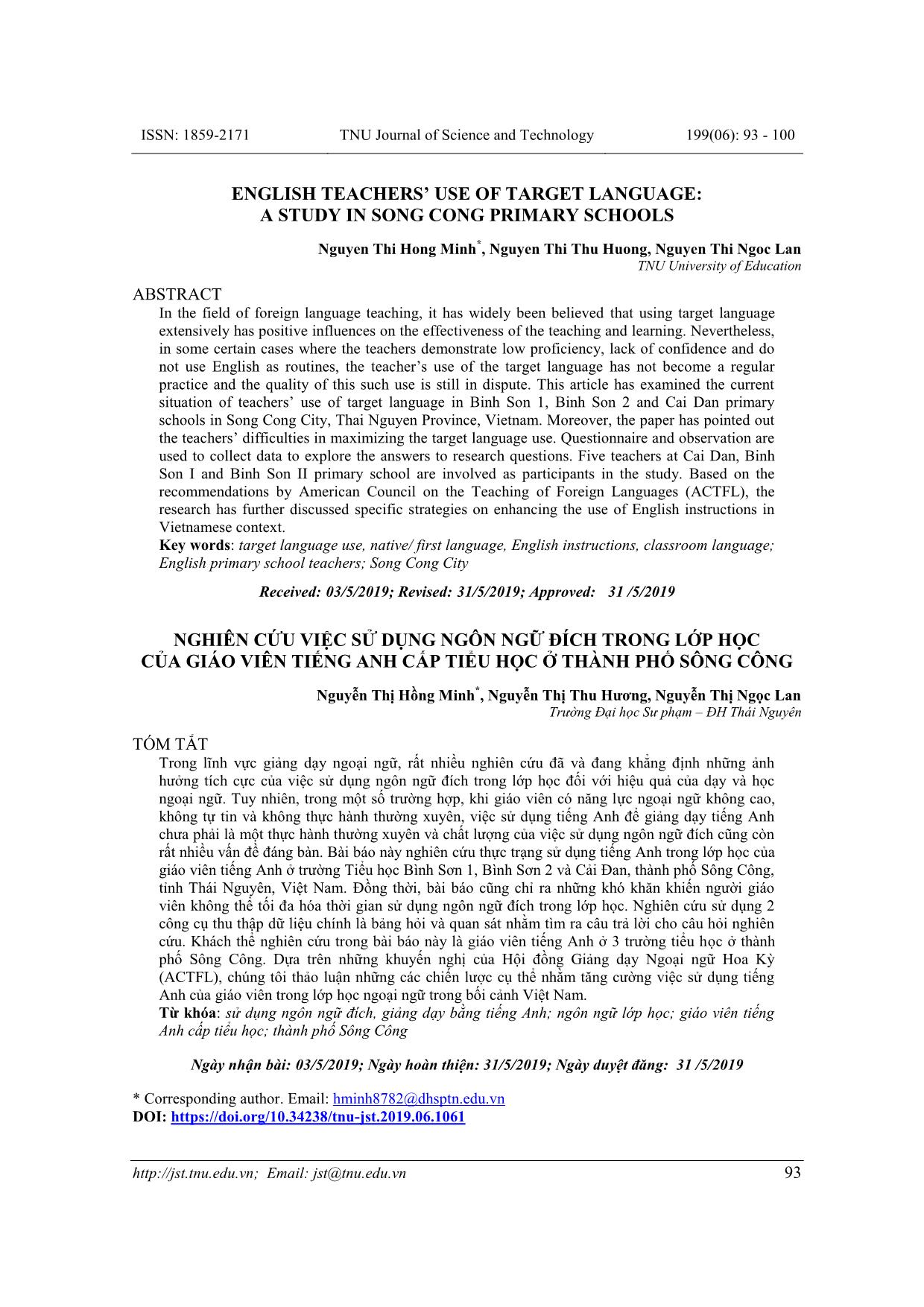
Trang 1
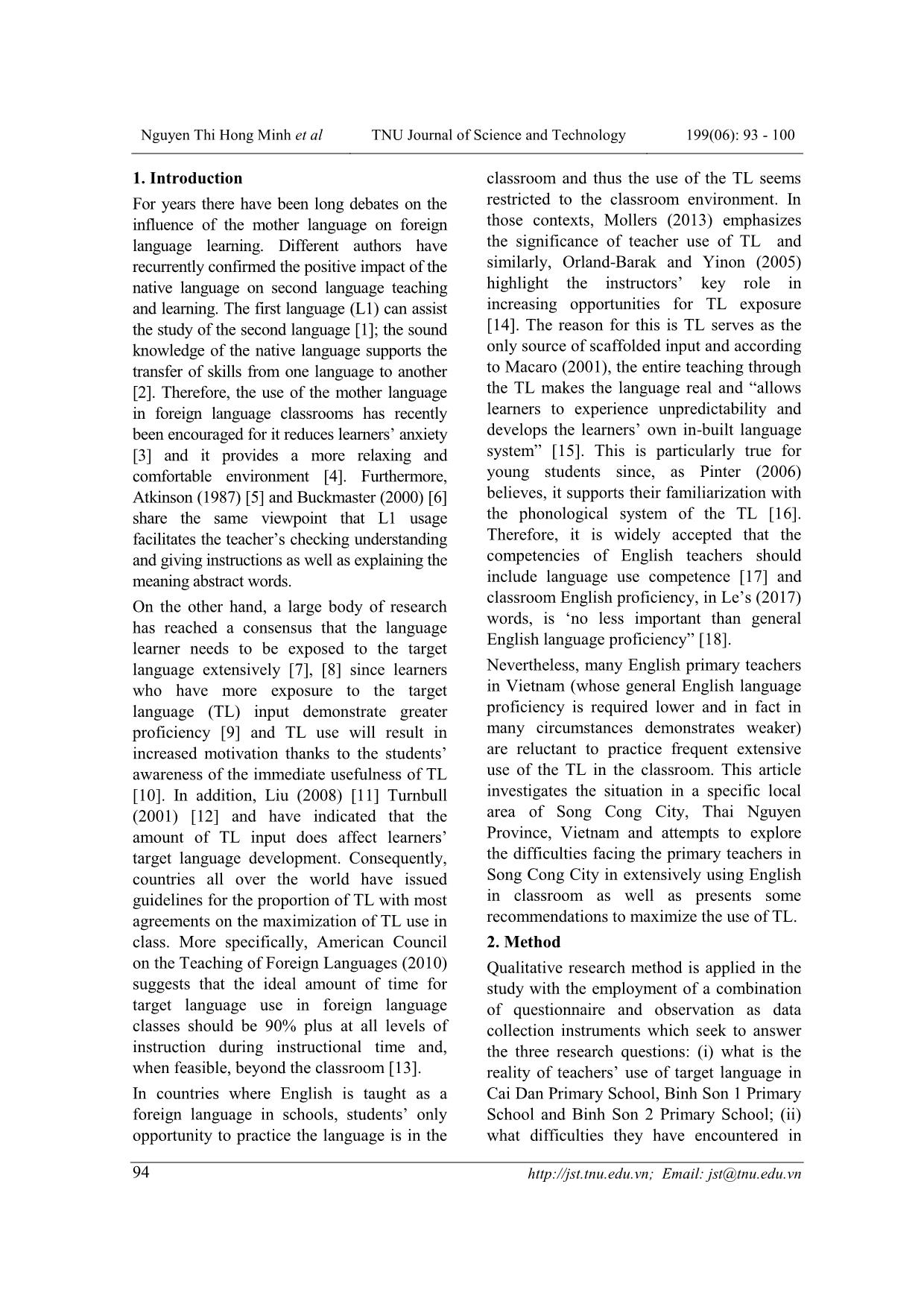
Trang 2
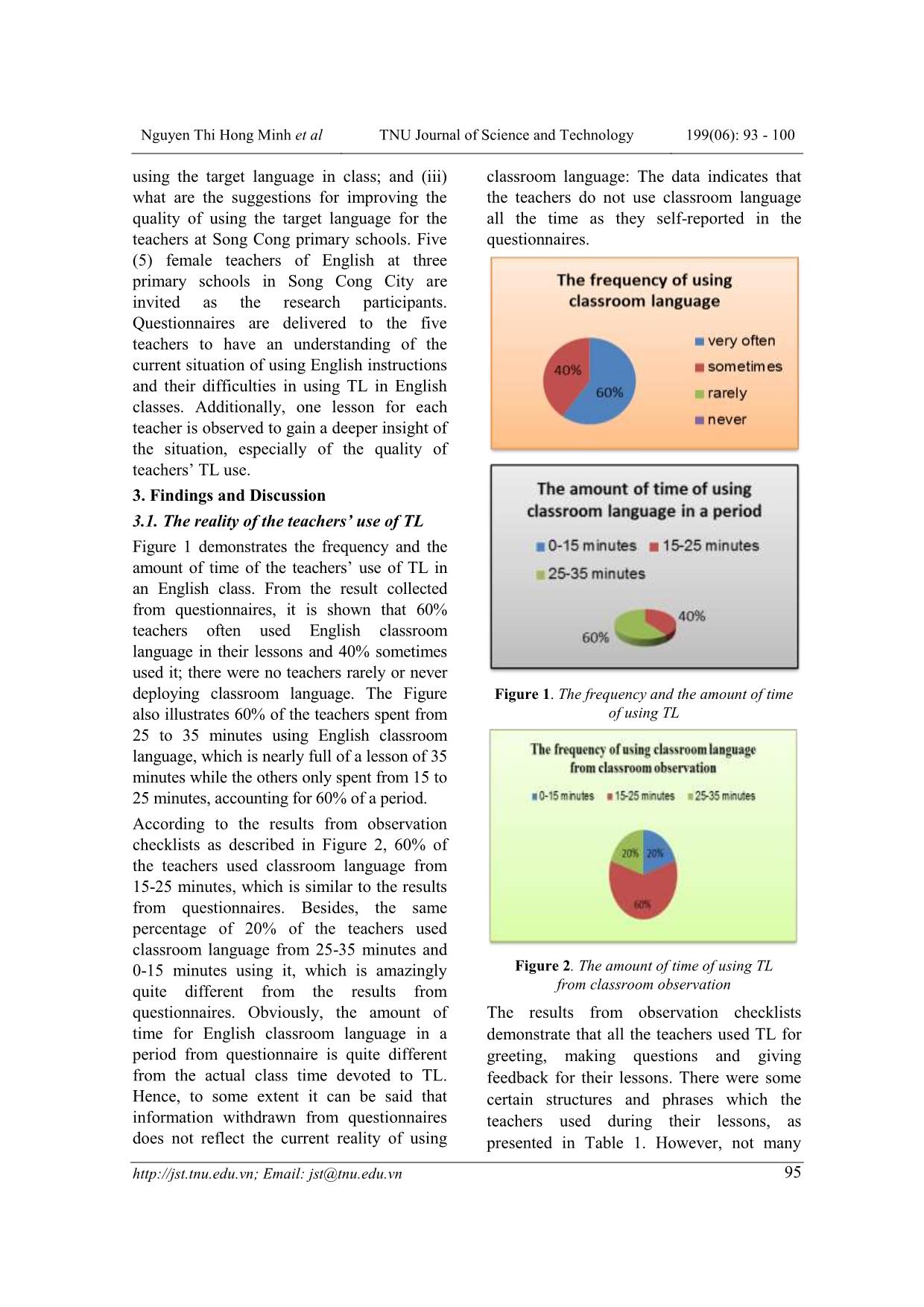
Trang 3
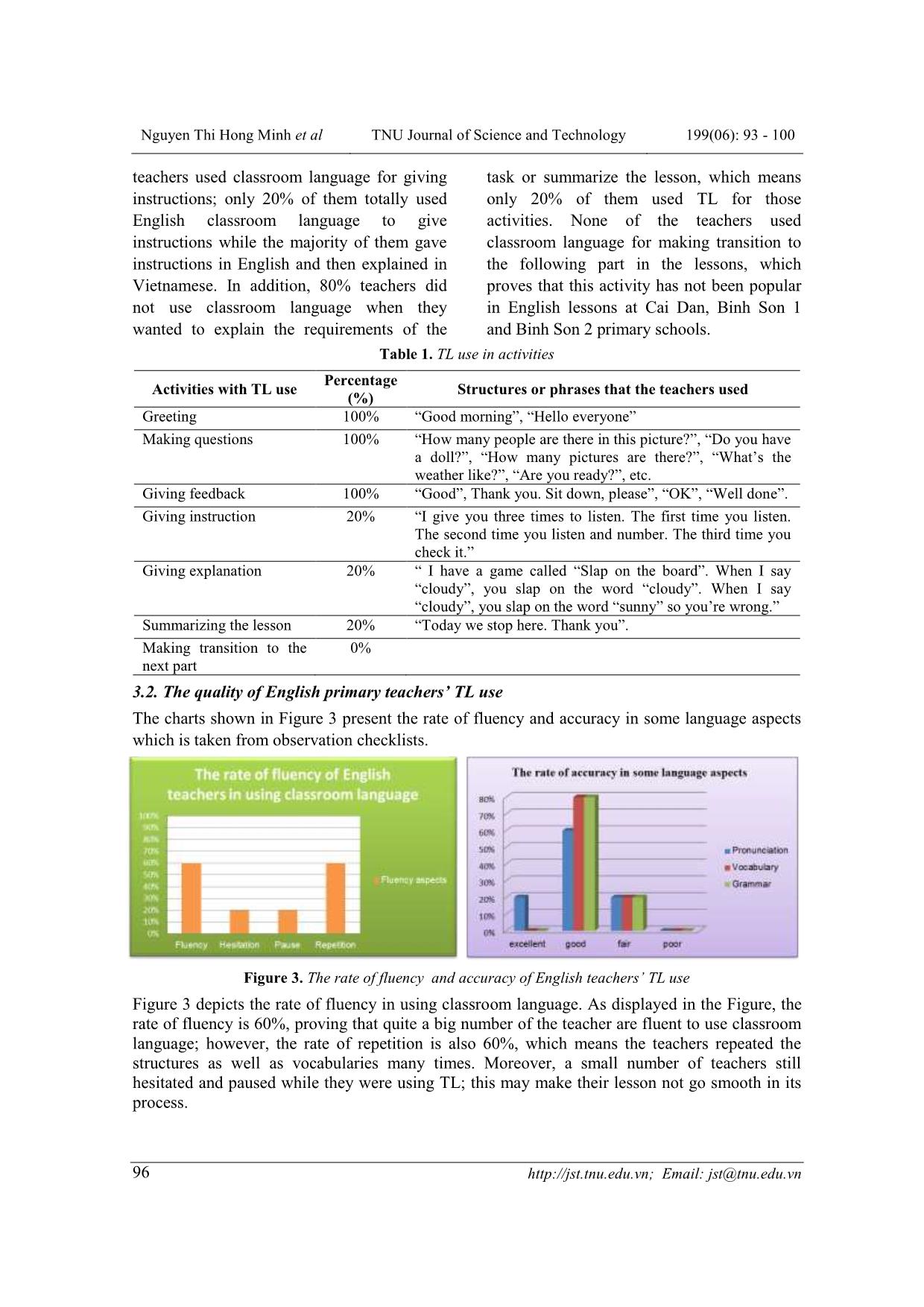
Trang 4
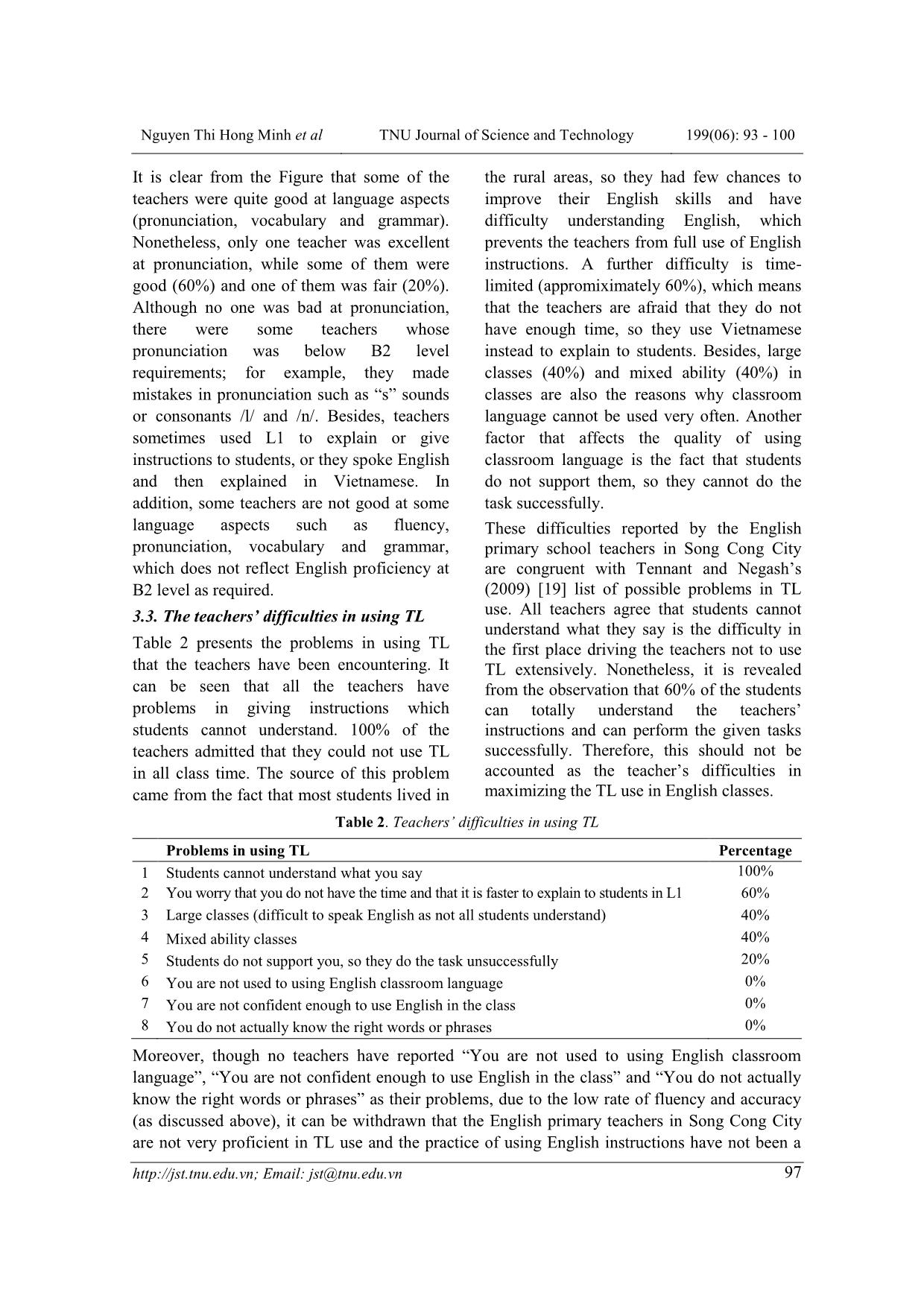
Trang 5
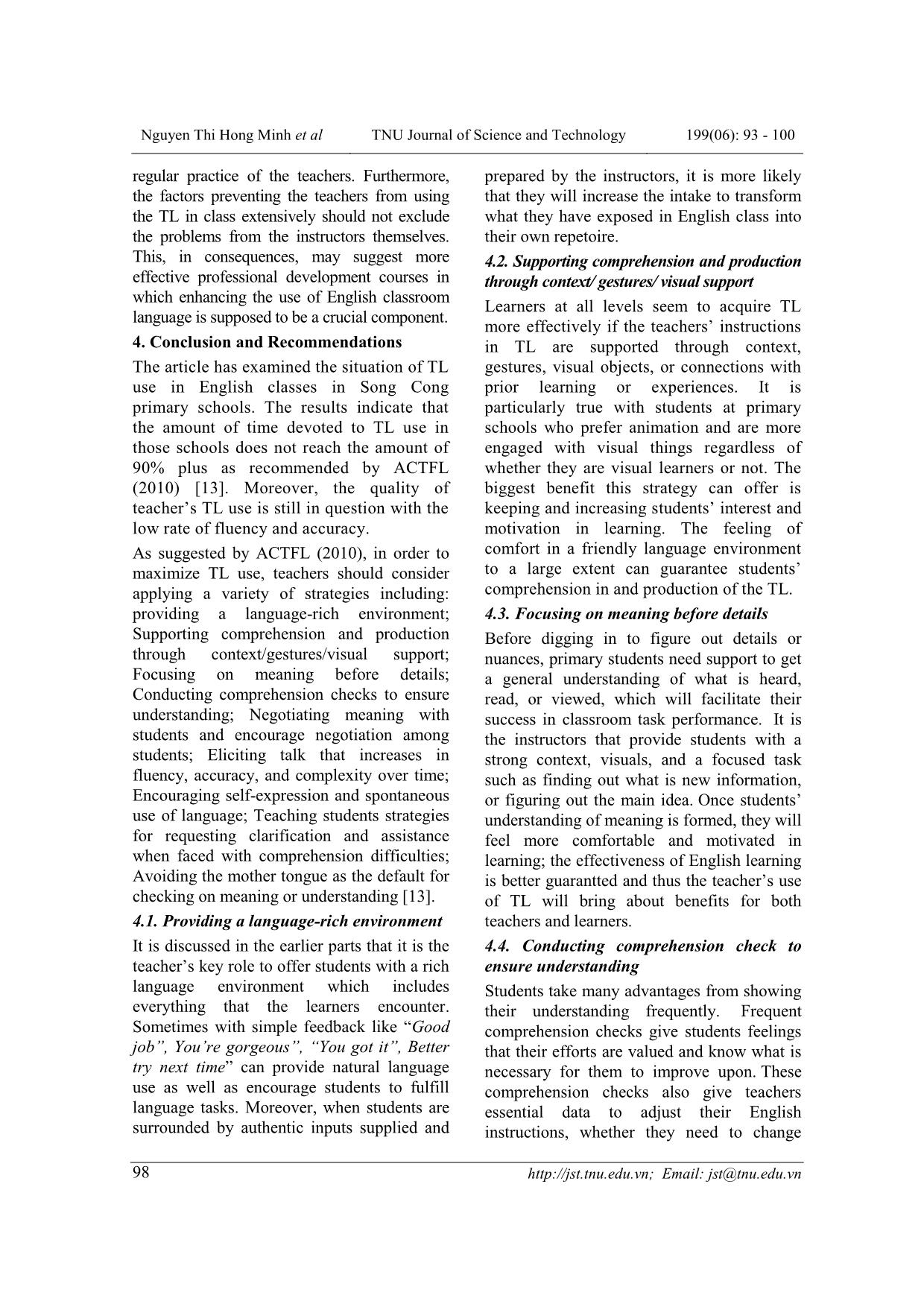
Trang 6
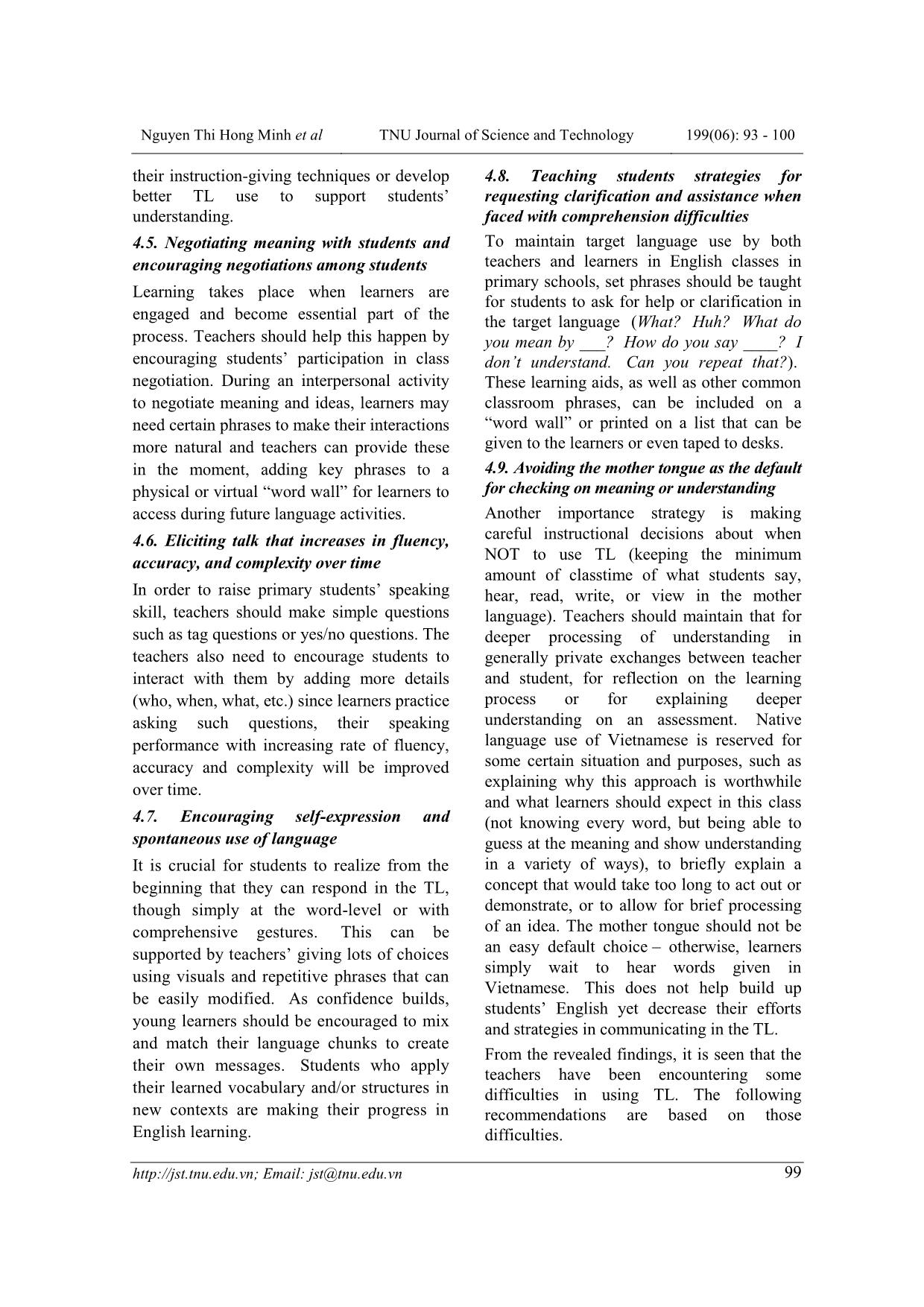
Trang 7
Tóm tắt nội dung tài liệu: Nghiên cứu việc sử dụng ngôn ngữ đích trong lớp học của giáo viên tiếng Anh cấp Tiểu học ở thành phố sông Công
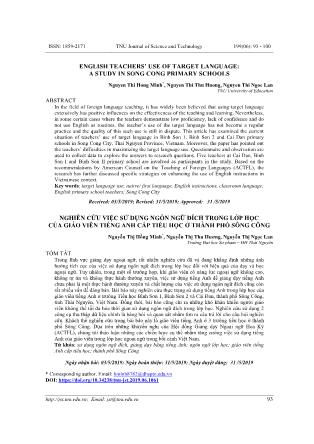
guage all the time as they self-reported in the questionnaires. Figure 1. The frequency and the amount of time of using TL Figure 2. The amount of time of using TL from classroom observation The results from observation checklists demonstrate that all the teachers used TL for greeting, making questions and giving feedback for their lessons. There were some certain structures and phrases which the teachers used during their lessons, as presented in Table 1. However, not many Nguyen Thi Hong Minh et al TNU Journal of Science and Technology 199(06): 93 - 100 Email: jst@tnu.edu.vn 96 teachers used classroom language for giving instructions; only 20% of them totally used English classroom language to give instructions while the majority of them gave instructions in English and then explained in Vietnamese. In addition, 80% teachers did not use classroom language when they wanted to explain the requirements of the task or summarize the lesson, which means only 20% of them used TL for those activities. None of the teachers used classroom language for making transition to the following part in the lessons, which proves that this activity has not been popular in English lessons at Cai Dan, Binh Son 1 and Binh Son 2 primary schools. Table 1. TL use in activities Activities with TL use Percentage (%) Structures or phrases that the teachers used Greeting 100% “Good morning”, “Hello everyone” Making questions 100% “How many people are there in this picture?”, “Do you have a doll?”, “How many pictures are there?”, “What’s the weather like?”, “Are you ready?”, etc. Giving feedback 100% “Good”, Thank you. Sit down, please”, “OK”, “Well done”. Giving instruction 20% “I give you three times to listen. The first time you listen. The second time you listen and number. The third time you check it.” Giving explanation 20% “ I have a game called “Slap on the board”. When I say “cloudy”, you slap on the word “cloudy”. When I say “cloudy”, you slap on the word “sunny” so you’re wrong.” Summarizing the lesson 20% “Today we stop here. Thank you”. Making transition to the next part 0% 3.2. The quality of English primary teachers’ TL use The charts shown in Figure 3 present the rate of fluency and accuracy in some language aspects which is taken from observation checklists. Figure 3. The rate of fluency and accuracy of English teachers’ TL use Figure 3 depicts the rate of fluency in using classroom language. As displayed in the Figure, the rate of fluency is 60%, proving that quite a big number of the teacher are fluent to use classroom language; however, the rate of repetition is also 60%, which means the teachers repeated the structures as well as vocabularies many times. Moreover, a small number of teachers still hesitated and paused while they were using TL; this may make their lesson not go smooth in its process. Nguyen Thi Hong Minh et al TNU Journal of Science and Technology 199(06): 93 - 100 Email: jst@tnu.edu.vn 97 It is clear from the Figure that some of the teachers were quite good at language aspects (pronunciation, vocabulary and grammar). Nonetheless, only one teacher was excellent at pronunciation, while some of them were good (60%) and one of them was fair (20%). Although no one was bad at pronunciation, there were some teachers whose pronunciation was below B2 level requirements; for example, they made mistakes in pronunciation such as “s” sounds or consonants /l/ and /n/. Besides, teachers sometimes used L1 to explain or give instructions to students, or they spoke English and then explained in Vietnamese. In addition, some teachers are not good at some language aspects such as fluency, pronunciation, vocabulary and grammar, which does not reflect English proficiency at B2 level as required. 3.3. The teachers’ difficulties in using TL Table 2 presents the problems in using TL that the teachers have been encountering. It can be seen that all the teachers have problems in giving instructions which students cannot understand. 100% of the teachers admitted that they could not use TL in all class time. The source of this problem came from the fact that most students lived in the rural areas, so they had few chances to improve their English skills and have difficulty understanding English, which prevents the teachers from full use of English instructions. A further difficulty is time- limited (appromiximately 60%), which means that the teachers are afraid that they do not have enough time, so they use Vietnamese instead to explain to students. Besides, large classes (40%) and mixed ability (40%) in classes are also the reasons why classroom language cannot be used very often. Another factor that affects the quality of using classroom language is the fact that students do not support them, so they cannot do the task successfully. These difficulties reported by the English primary school teachers in Song Cong City are congruent with Tennant and Negash’s (2009) [19] list of possible problems in TL use. All teachers agree that students cannot understand what they say is the difficulty in the first place driving the teachers not to use TL extensively. Nonetheless, it is revealed from the observation that 60% of the students can totally understand the teachers’ instructions and can perform the given tasks successfully. Therefore, this should not be accounted as the teacher’s difficulties in maximizing the TL use in English classes. Table 2. Teachers’ difficulties in using TL Problems in using TL Percentage 1 Students cannot understand what you say 100% 2 You worry that you do not have the time and that it is faster to explain to students in L1 60% 3 Large classes (difficult to speak English as not all students understand) 40% 4 Mixed ability classes 40% 5 Students do not support you, so they do the task unsuccessfully 20% 6 You are not used to using English classroom language 0% 7 You are not confident enough to use English in the class 0% 8 You do not actually know the right words or phrases 0% Moreover, though no teachers have reported “You are not used to using English classroom language”, “You are not confident enough to use English in the class” and “You do not actually know the right words or phrases” as their problems, due to the low rate of fluency and accuracy (as discussed above), it can be withdrawn that the English primary teachers in Song Cong City are not very proficient in TL use and the practice of using English instructions have not been a Nguyen Thi Hong Minh et al TNU Journal of Science and Technology 199(06): 93 - 100 Email: jst@tnu.edu.vn 98 regular practice of the teachers. Furthermore, the factors preventing the teachers from using the TL in class extensively should not exclude the problems from the instructors themselves. This, in consequences, may suggest more effective professional development courses in which enhancing the use of English classroom language is supposed to be a crucial component. 4. Conclusion and Recommendations The article has examined the situation of TL use in English classes in Song Cong primary schools. The results indicate that the amount of time devoted to TL use in those schools does not reach the amount of 90% plus as recommended by ACTFL (2010) [13]. Moreover, the quality of teacher’s TL use is still in question with the low rate of fluency and accuracy. As suggested by ACTFL (2010), in order to maximize TL use, teachers should consider applying a variety of strategies including: providing a language-rich environment; Supporting comprehension and production through context/gestures/visual support; Focusing on meaning before details; Conducting comprehension checks to ensure understanding; Negotiating meaning with students and encourage negotiation among students; Eliciting talk that increases in fluency, accuracy, and complexity over time; Encouraging self-expression and spontaneous use of language; Teaching students strategies for requesting clarification and assistance when faced with comprehension difficulties; Avoiding the mother tongue as the default for checking on meaning or understanding [13]. 4.1. Providing a language-rich environment It is discussed in the earlier parts that it is the teacher’s key role to offer students with a rich language environment which includes everything that the learners encounter. Sometimes with simple feedback like “Good job”, You’re gorgeous”, “You got it”, Better try next time” can provide natural language use as well as encourage students to fulfill language tasks. Moreover, when students are surrounded by authentic inputs supplied and prepared by the instructors, it is more likely that they will increase the intake to transform what they have exposed in English class into their own repetoire. 4.2. Supporting comprehension and production through context/ gestures/ visual support Learners at all levels seem to acquire TL more effectively if the teachers’ instructions in TL are supported through context, gestures, visual objects, or connections with prior learning or experiences. It is particularly true with students at primary schools who prefer animation and are more engaged with visual things regardless of whether they are visual learners or not. The biggest benefit this strategy can offer is keeping and increasing students’ interest and motivation in learning. The feeling of comfort in a friendly language environment to a large extent can guarantee students’ comprehension in and production of the TL. 4.3. Focusing on meaning before details Before digging in to figure out details or nuances, primary students need support to get a general understanding of what is heard, read, or viewed, which will facilitate their success in classroom task performance. It is the instructors that provide students with a strong context, visuals, and a focused task such as finding out what is new information, or figuring out the main idea. Once students’ understanding of meaning is formed, they will feel more comfortable and motivated in learning; the effectiveness of English learning is better guarantted and thus the teacher’s use of TL will bring about benefits for both teachers and learners. 4.4. Conducting comprehension check to ensure understanding Students take many advantages from showing their understanding frequently. Frequent comprehension checks give students feelings that their efforts are valued and know what is necessary for them to improve upon. These comprehension checks also give teachers essential data to adjust their English instructions, whether they need to change Nguyen Thi Hong Minh et al TNU Journal of Science and Technology 199(06): 93 - 100 Email: jst@tnu.edu.vn 99 their instruction-giving techniques or develop better TL use to support students’ understanding. 4.5. Negotiating meaning with students and encouraging negotiations among students Learning takes place when learners are engaged and become essential part of the process. Teachers should help this happen by encouraging students’ participation in class negotiation. During an interpersonal activity to negotiate meaning and ideas, learners may need certain phrases to make their interactions more natural and teachers can provide these in the moment, adding key phrases to a physical or virtual “word wall” for learners to access during future language activities. 4.6. Eliciting talk that increases in fluency, accuracy, and complexity over time In order to raise primary students’ speaking skill, teachers should make simple questions such as tag questions or yes/no questions. The teachers also need to encourage students to interact with them by adding more details (who, when, what, etc.) since learners practice asking such questions, their speaking performance with increasing rate of fluency, accuracy and complexity will be improved over time. 4.7. Encouraging self-expression and spontaneous use of language It is crucial for students to realize from the beginning that they can respond in the TL, though simply at the word-level or with comprehensive gestures. This can be supported by teachers’ giving lots of choices using visuals and repetitive phrases that can be easily modified. As confidence builds, young learners should be encouraged to mix and match their language chunks to create their own messages. Students who apply their learned vocabulary and/or structures in new contexts are making their progress in English learning. 4.8. Teaching students strategies for requesting clarification and assistance when faced with comprehension difficulties To maintain target language use by both teachers and learners in English classes in primary schools, set phrases should be taught for students to ask for help or clarification in the target language (What? Huh? What do you mean by ___? How do you say ____? I don’t understand. Can you repeat that?). These learning aids, as well as other common classroom phrases, can be included on a “word wall” or printed on a list that can be given to the learners or even taped to desks. 4.9. Avoiding the mother tongue as the default for checking on meaning or understanding Another importance strategy is making careful instructional decisions about when NOT to use TL (keeping the minimum amount of classtime of what students say, hear, read, write, or view in the mother language). Teachers should maintain that for deeper processing of understanding in generally private exchanges between teacher and student, for reflection on the learning process or for explaining deeper understanding on an assessment. Native language use of Vietnamese is reserved for some certain situation and purposes, such as explaining why this approach is worthwhile and what learners should expect in this class (not knowing every word, but being able to guess at the meaning and show understanding in a variety of ways), to briefly explain a concept that would take too long to act out or demonstrate, or to allow for brief processing of an idea. The mother tongue should not be an easy default choice – otherwise, learners simply wait to hear words given in Vietnamese. This does not help build up students’ English yet decrease their efforts and strategies in communicating in the TL. From the revealed findings, it is seen that the teachers have been encountering some difficulties in using TL. The following recommendations are based on those difficulties.
File đính kèm:
 nghien_cuu_viec_su_dung_ngon_ngu_dich_trong_lop_hoc_cua_giao.pdf
nghien_cuu_viec_su_dung_ngon_ngu_dich_trong_lop_hoc_cua_giao.pdf

